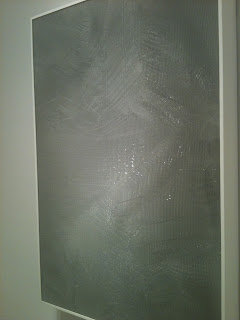Sperone Westwater
Heinz Mack & Old Masters
My favorite opening this weekend happened at the Sperone Westwater Gallery with a combination of the old versus the new. The first three floors were filled with an elegant fizz of metal and glass work covering the high ceilinged walls from bottom to top. Heinz Mack's work actually looks like it was made for the Gallery´s new building, but the work presented "Early Metal Reliefs" was from the ten years between 1957 - 1967. This is also the era of the German Zero group that he founded together with Otto Piene in 1956. The groups mission was to sign off the past and start again at Zero. A post-war art movement that was like a European version of the minimalism so popular in America.
Mack’s metal reliefs are characterized by their shimmering industrial surfaces, made from aluminum, Plexiglas, wood, glass and stainless steel: all materials that were radically unfamiliar for sculpture at the time. His aim was to abandon the traditional idea of pictorial space and focus instead on an overall surface play of light, reflection and vibration, in the process creating immaterial effects from material form.
In his essay for the brochure which accompanied Mack’s first show in Paris in 1959 at the Galerie Iris Clert, Yves Klein wrote: “the reliefs in aluminum of Mack […] come from the delicate, discrete and timid love he has always felt for color though always refusing to approach it.”
- Sperone Westwater (Press Release)
We were fortunate enough to meet the illuminating master, who continues to work in a small town called Monchengladbach outside Dusseldorf (Germany).
On the 4th floor were the elevator is being used as an extension of the room, were a sacred exhibit of old masters. I am intrigued by their initiative to bring in the old together with the Contemporary. A collaboration with the Robilant + Voena Gallery (Milan/London). It hit me that this could be beginning of a new "Renaissance" for old paintings. The most known masters are all taken by Museums or private collections so there is very little left on the market. But, there were so many other great painters during this time like Caraviggio's teacher Casini, here with his version of "David with the Head of Goliath".

Artemisia Gentileschi (1593-1653)
Portrait of an Unidentified Man
*Photo courtesy of Sperone Westwater Gallery
Artemisia Gentileschi was one of the few but highly regarded FEMALE artists of the Baroque. Her life has also been portrayed in the movie Artemisia. A great well-acted film I watched a few years ago, about her struggles to be allowed to paint in a male dominated world and a rape trial where she was the plaintiff.
Tiberio Titi
Portrait of Ferdinando Gonzaga, Duke of Mantua
(C. 1617)
All artists from an area that was important for the beginning of modern art. With new findings, re-discoveries and new importance attributed to lesser known but not less important artist from the 17th and 18th Century is (I think) going to bring the old masters into the Contemporary House.
Casini "David with the head of Goliath"
It will be exciting to see if other Contemporary Galleries will follow the lead.
It is interesting what a breeze it was to go from "Metal to Paint" like each exhibit induced a stronger message to the other because of it.
With Love
Kristin






































